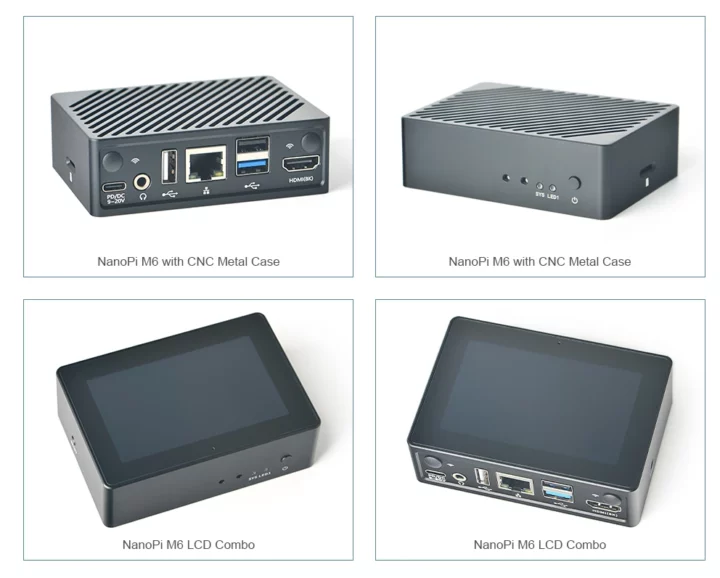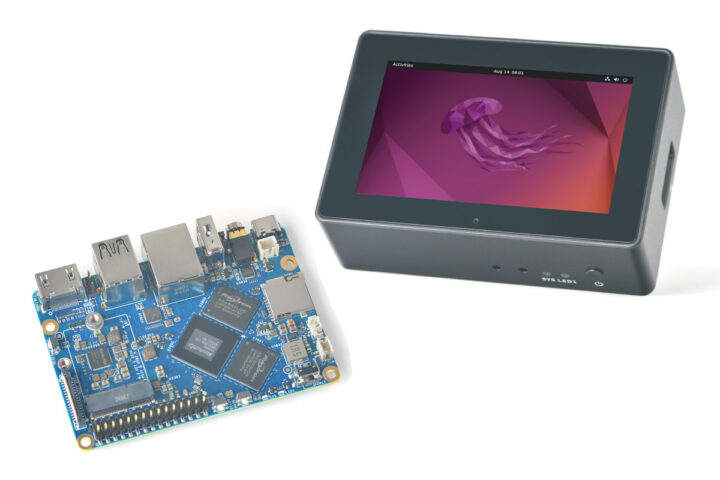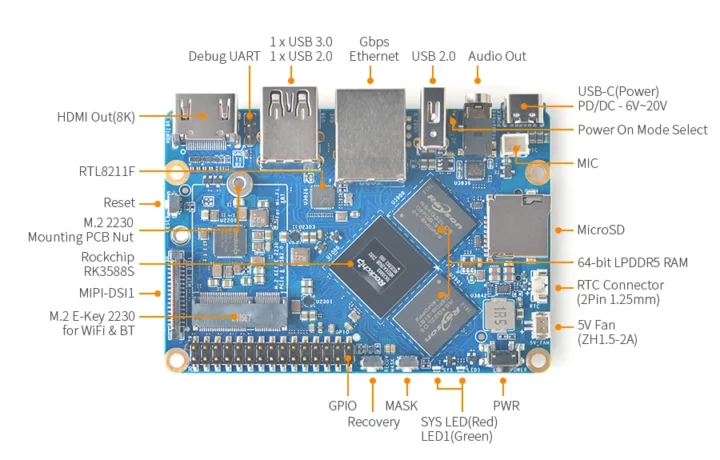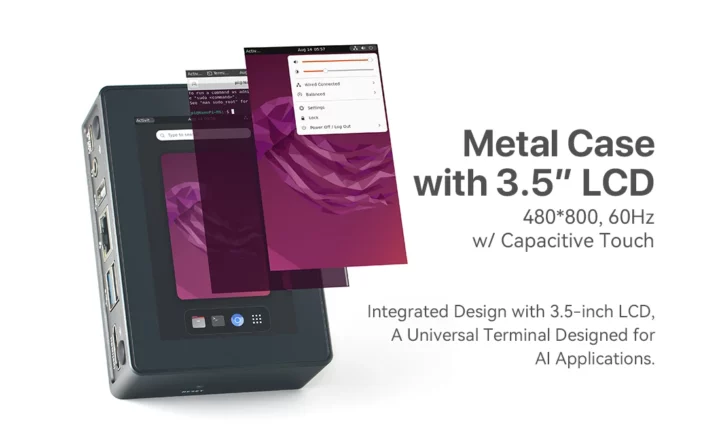NanoPi M6 is a Rockchip RK3588S SBC (single board computer) that is also offered as a complete fanless HMI solution with a metal case and a 3.5-inch capacitive touchscreen display with 800×480 resolution.
The M6 is offered with 4GB to 32GB LPDDR5 memory, supports microSD, eMMC flash module, and M.2 NVMe SSD bootable storage, features one HDMI 2.1 port, two MIPI DSI connectors, two MIPI CSI camera connectors, gigabit Ethernet, an M.2 E-Key socket for WiFi and Bluetooth, and a 30-pin GPIO header for expansion among a few other ports and features.
NanoPi M6 specifications:
- SoC – Rockchip RK3588S
- CPU – Octa-core processor with 4x Cortex-A76 cores @ up to 2.4 GHz, 4x Cortex-A55 cores @ up to 1.8 GHz
- GPU – Arm Mali-G610 MP4 GPU compatible with OpenGL ES 3.2, OpenCL 2.2, and Vulkan 1.2 APIs
- VPU – 8Kp60 video decoder for H.265/AVS2/VP9/H.264/AV1 codecs, 8Kp30 H.265/H.264 video encoder
- AI accelerator – 6 TOPS NPU
- System Memory – 4GB, 16GB, or 32GB LPDDR5 at 2400 MHz
- Storage
- eMMC module socket supporting HS400 mode
- MicroSD card slot with SDR104 mode support
- M.2 M-Key socket with PCIe 2.1 x1 for NVMe SSDs
- Video output
- HDMI 2.1 port up to 7680×4320 @ 60Hz; RGB/YUV(up to 10bit) format
- 2x 4-lane MIPI-DSI connectors
- Optional Display – 3.5-inch touchscreen LCD with 800×480 resolution and capacitive touchscreen connected to one of the MIPI DSI connectors
- Camera input
- 4-lane MIPI-CSI V1.2 connector
- 4-lane MIPI-CSI D/C PHY connector
- Audio
- 3.5mm jack for stereo headphone output
- 2.0mm PH-2A connector for analog microphone input
- Networking
- Gigabit Ethernet RJ45 port
- Optional WiFi and Bluetooth via M.2 E-key socket with PCIe 2.1 x1 and USB 2.0 host
- USB
- 1x USB 3.0 Type-A port
- 2x USB 2.0 Type-A ports
- Expansion
- M.2 Key-M socket for PCIe storage
- M.2 Key-E socket for WiFi/Bluetooth (PCIe/USB)
- 30-pin 2.54mm GPIO header with up to 1x SPI, 6x UART, 3x I2C, 1x SPDIF, 4x PWM, 20x GPIO
- Debugging – 3-pin header for serial console
- Misc
- 2x user LEDs
- 2-pin RTC battery input connector for low-power HYM8563TS RTC IC
- Buttons – MASK, Reset, Recovery, Power
- 5V fan connector
- Power supply – 6V~20V input via USB-C with PD support
- Dimensions & Weight
- SBC – 90 x 62 mm (8-layer PCB) | 52 grams
- Metal case – 94.5 x 68 x 30mm | 252 grams
- Metal case + LCD – 99 x 68 x 31mm | 275 grams
- Temperature Range – 0°C to 70°C
FriendlyELEC provides OS images for Debian 12 Core (headless), Debian 11 Desktop and Minimal, Ubuntu 20.04 Desktop, Ubuntu 22.04 Desktop and Minimal, Xubuntu 22.04, Android 12 TV, Android 12 Tablet, OpenMediaVault, and FriendlyWrt, a fork of OpenWrt. All images are based on Linux 6.1, and Ubuntu 24.04 support is coming soon. You’ll find those and other information in the wiki. I would expect the NanoPi M6 to benefit from the software work done on the earlier NanoPi R6S that we reviewed with Ubuntu 22.04.
The company stress-tested the NanoPi M6 in its metal case with or without display and the maximum CPU temperature was under 70°C, and since the board does not come with WiFi, they also provide a list of supported WiFi dongles. This information can be found on the product page where you can also purchase the NanoPi M6 for $70 and up depending on options. The top model with 32GB RAM, a 64GB eMMC flash module, a metal case, and a 3.5-inch touchscreen display goes for $205.


Jean-Luc started CNX Software in 2010 as a part-time endeavor, before quitting his job as a software engineering manager, and starting to write daily news, and reviews full time later in 2011.
Support CNX Software! Donate via cryptocurrencies, become a Patron on Patreon, or purchase goods on Amazon or Aliexpress









Looking at all DDR5 RAM rates. The lowest DDR5 RAM rate is 4000 MHz. The highest DDR5 RAM rate is 8800 MHz. So this RAM at 2400 MHz has to be DDR4 RAM, and NOT DDR5. This is what wikipedia has stated.
Here 2400 MHz means “4800 MHz” or more exactly 4800 MT/s.
As I understand it, 2400 MHz is the actual frequency of the memory, but with DDR, people just convert it to 4800 MHz even though it’s not 100% accurate.
> 2400 MHz is the actual frequency of the memory, but with DDR, people just convert it to 4800 MHz even though it’s not 100% accurate
Some people indeed to that but they’re always wrong. I don’t know why they’re doing that, as usually people don’t speak about MHz but Mbps for network link speeds, and for PCIe we’re correctly speaking about GT/s not GHz.
Wherever MHz are used with DRAM frequencies, it’s always the real frequency (here 2400 MHz), and it’s very rarely seen, except on technical tools (e.g. u-boot’s DDR training output message), hardware specifications (e.g. the memory controller or the chip itself).
The other, more commonly used value, is the transfer rate expressed as you said in MT/s (megatransfers per second), and very often written without any unit and as a suffix after DDR- or DDR5- etc. You multiply that by the bus width and you get the memory bandwidth in Mbit/s. Even BIOSes will let you select the DRAM speed without specifying any unit, which always implies the DDR rating.
I would say that it’s a rare area in computers which is generally correct and not deceptive (compared, for example, to backup tapes that were advertising double sizes “assuming a 2.0x compression factor” for example). It’s only some users who insist on incorrectly placing “MHz” after the DDR rating. Either you’re using DDR-4800 or you’re having your DDR at 2400 MHz, hence claiming twice the transfer rate. It’s often easier to speak about the DDR rating since it’s used to sell the DRAM, so the right practice for non-tech users should be to never append “MHz” after the numbers they see. And if they need a unit because they’re announcing a single number, they should say MT/s or “megatransfers per second”.